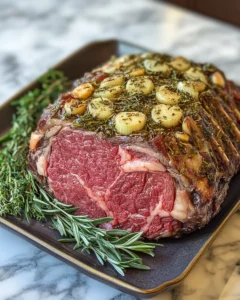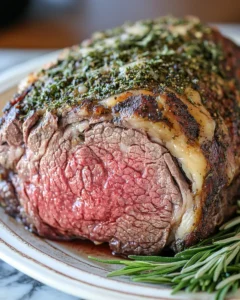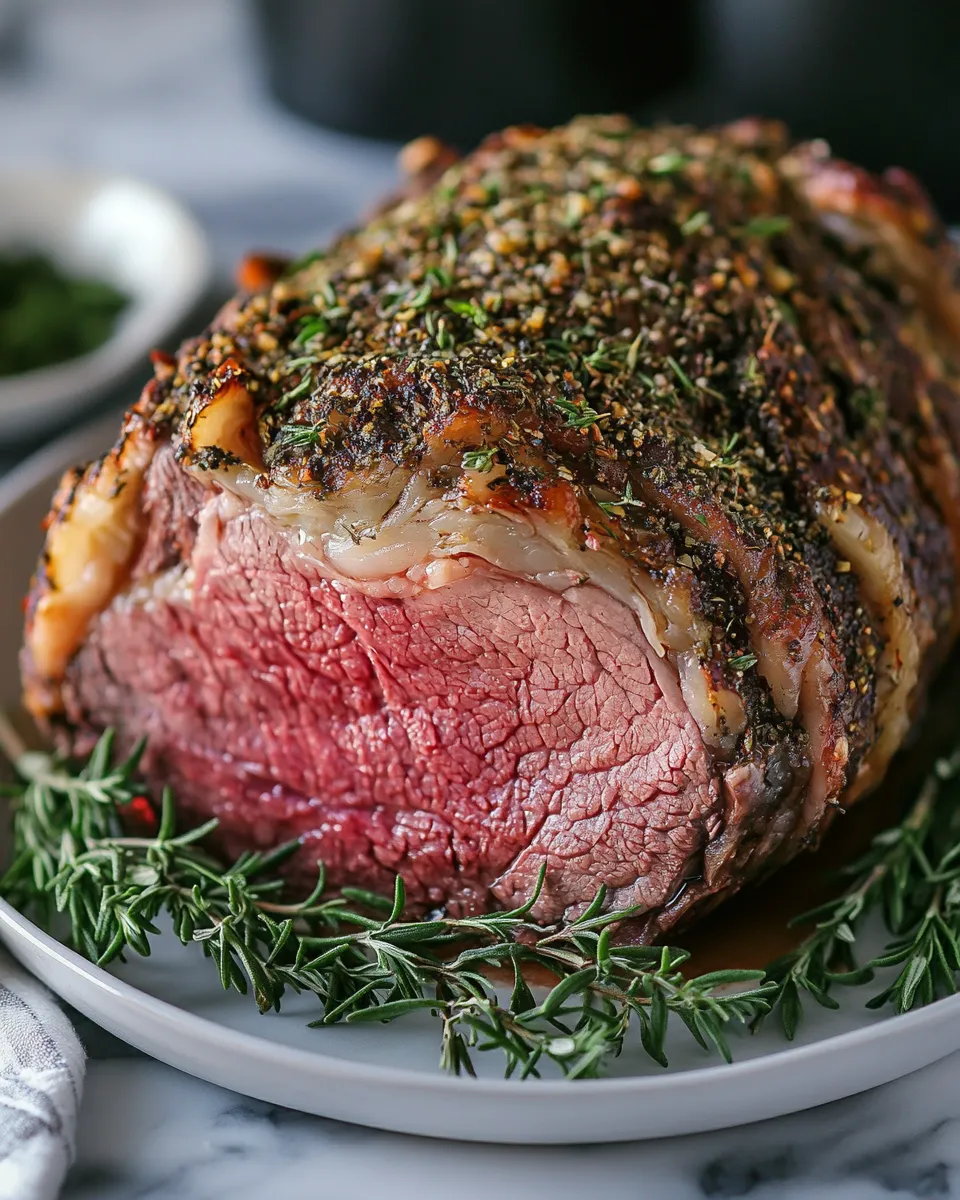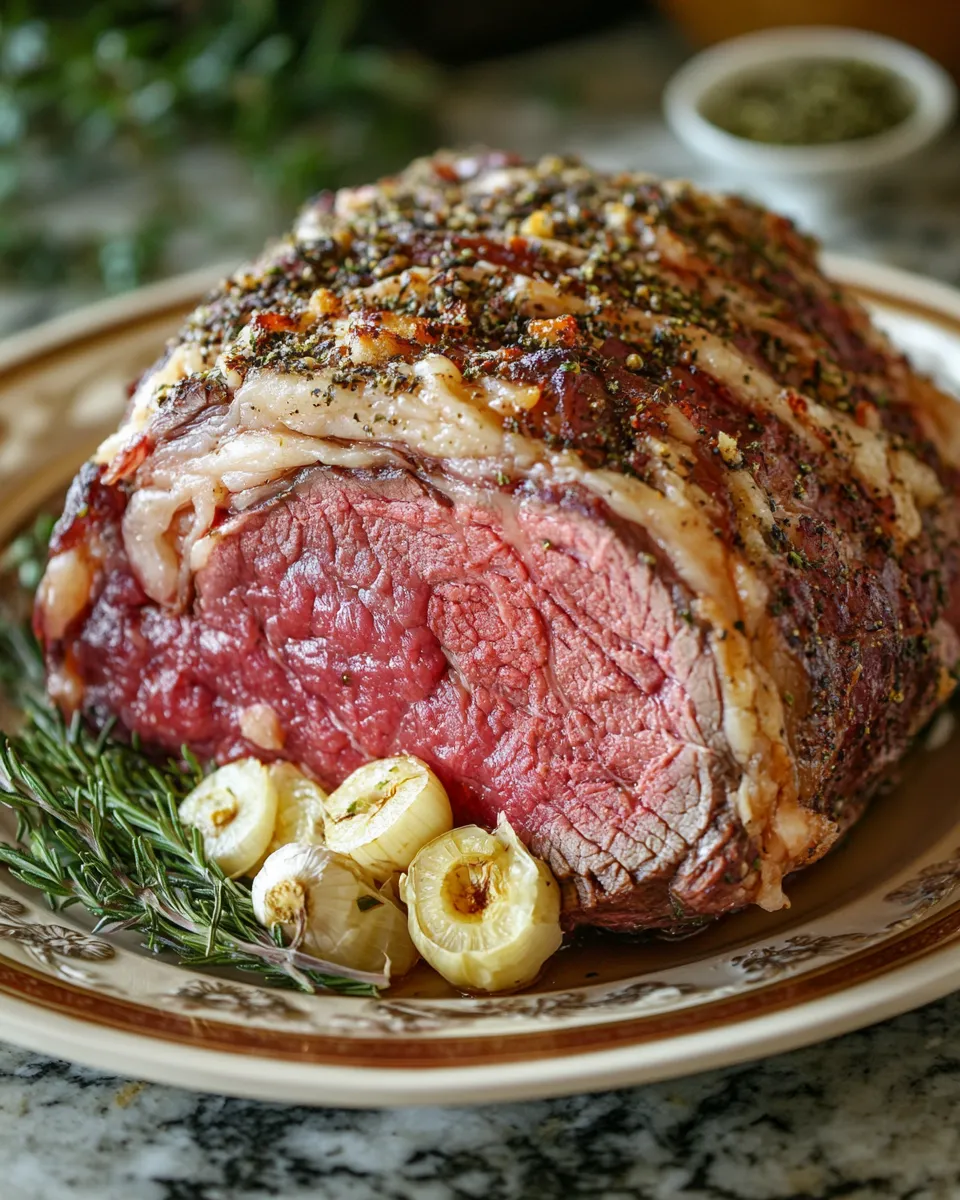There’s something undeniably majestic about a prime rib roast, especially when it emerges from the oven golden, aromatic, and tender. The Juicy Garlic and Sage Prime Rib Roast is a centerpiece that turns any gathering into a special occasion. Whether it’s a holiday dinner, a celebratory family feast, or a cozy Sunday evening, this roast promises to deliver an unforgettable experience.
Inspired by classic culinary traditions that emphasize simple, robust flavors, this recipe balances the boldness of garlic with the earthy warmth of fresh sage. Every bite is juicy, flavorful, and perfectly seasoned, making it the ultimate comfort dish for meat lovers. The aroma alone fills the home with a sense of festivity and warmth, encouraging friends and family to gather around the table and savor each moment together.
Cooking a prime rib may seem intimidating, but with the right guidance and preparation, anyone can master it. This recipe is designed to make the process approachable, guiding you from selecting the perfect cut to serving slices that practically melt in your mouth.
Ingredients
-
1 (5–7 pounds) prime rib roast, bone-in
-
4 tablespoons unsalted butter, softened
-
6 garlic cloves, minced
-
2 tablespoons fresh sage, finely chopped
-
1 tablespoon fresh rosemary, finely chopped
-
2 teaspoons salt
-
1 teaspoon black pepper
-
1 teaspoon onion powder
-
1 teaspoon paprika
-
1 tablespoon olive oil
-
Optional: fresh rosemary and sage sprigs for garnish
Directions
1. Preparing the Prime Rib
Begin by removing the prime rib roast from the refrigerator at least 2 hours before cooking. Allowing it to come to room temperature ensures even cooking. While the roast rests, preheat your oven to 450°F (232°C).
Pat the meat dry with paper towels to remove any excess moisture. This helps the seasoning adhere better and promotes a beautifully browned crust.
2. Making the Garlic and Sage Butter
In a small bowl, combine softened butter, minced garlic, chopped sage, rosemary, salt, black pepper, onion powder, and paprika. Mix thoroughly until all ingredients are evenly incorporated. This aromatic butter mixture will infuse the roast with flavor while keeping the meat moist.
3. Seasoning the Roast
Gently loosen the fat cap from the top of the roast with a small knife. Spread a generous portion of the garlic and sage butter beneath the fat layer, pressing it into the meat. Then rub the remaining butter mixture evenly over the outside of the roast. Drizzle the olive oil over the surface to help the crust brown beautifully in the oven.
4. Roasting the Prime Rib
Place the seasoned roast on a rack in a roasting pan, fat side up. Insert an oven-safe meat thermometer into the thickest part of the roast, avoiding contact with the bone.
Roast at 450°F (232°C) for 20 minutes to sear the exterior. Then, reduce the oven temperature to 325°F (163°C) and continue roasting until the internal temperature reaches your desired level of doneness:
-
Rare: 120–125°F (49–52°C)
-
Medium-rare: 130–135°F (54–57°C)
-
Medium: 140–145°F (60–63°C)
For a 5–7 pound roast, this typically takes 1.5–2.5 hours after the initial sear.
5. Resting the Roast
Once the prime rib reaches your desired temperature, remove it from the oven and transfer it to a cutting board. Tent loosely with foil and let it rest for 20–30 minutes. Resting allows the juices to redistribute throughout the meat, ensuring every slice is moist and flavorful.
6. Carving and Serving
Using a sharp carving knife, slice the prime rib against the grain into ½-inch thick slices. Serve on a warmed platter, garnished with fresh rosemary and sage sprigs for an elegant presentation. Pair with your favorite sides, such as roasted vegetables, creamy mashed potatoes, or a crisp green salad, for a complete meal.
Tips for the Perfect Prime Rib
-
Choose the Right Cut: Look for a prime rib roast with even marbling. Marbling contributes to flavor and tenderness. Bone-in roasts are ideal for flavor, but boneless can be used if preferred.
-
Room Temperature Meat: Always let your roast rest at room temperature before cooking. This ensures even cooking from edge to center.
-
Use a Meat Thermometer: For precision, a thermometer is essential. Avoid cutting the roast to check doneness, as this releases juices.
-
Resting is Crucial: Never skip resting. It allows the juices to settle, resulting in a juicier roast.
-
Customize the Herbs: If you love aromatic herbs, feel free to experiment with thyme, parsley, or oregano alongside sage and rosemary.
Serving Suggestions
This Juicy Garlic and Sage Prime Rib Roast pairs wonderfully with a variety of side dishes:
-
Creamy Mashed Potatoes: Rich and buttery, they soak up the roast’s flavorful juices.
-
Roasted Root Vegetables: Carrots, parsnips, and sweet potatoes add a natural sweetness that complements the savory meat.
-
Garlic Green Beans: A quick sauté with olive oil and garlic adds a crisp, fresh element to the meal.
-
Yorkshire Pudding: Traditional and fluffy, perfect for absorbing the delicious roast juices.
-
Simple Green Salad: A light salad with vinaigrette balances the richness of the meat.
For an elevated dining experience, serve with a rich, savory gravy made from the pan drippings.
Why Garlic and Sage Work Perfectly Together
Garlic and sage are a classic culinary pairing for a reason. Garlic provides a bold, robust flavor that enhances the natural richness of the beef. Sage contributes an earthy, slightly peppery note that complements the meat without overpowering it. When combined in a butter rub, these flavors penetrate the roast, creating a harmonious balance of aroma and taste. The result is a roast that is deeply flavorful and indulgently juicy.
How to Make Your Prime Rib Extra Juicy
Achieving a perfectly juicy prime rib requires attention to technique:
-
Butter Under the Fat Cap: By spreading the garlic and sage butter beneath the fat layer, the flavors infuse the meat as it cooks.
-
Slow and Steady Cooking: After searing, cooking at a lower temperature ensures even doneness and prevents the meat from drying out.
-
Proper Resting: As mentioned, resting allows juices to redistribute. Skipping this step can lead to a dry roast.
-
Do Not Overcook: Prime rib is best enjoyed medium-rare to medium. Overcooking can result in a tougher texture.
Storing and Reheating Leftovers
Prime rib leftovers are a true gift. To store, wrap slices tightly in foil or place in an airtight container and refrigerate for up to 4 days. Reheat gently in the oven at 250°F (121°C) until warmed through. Avoid microwaving, which can dry out the meat. Leftovers also make excellent sandwiches, served with horseradish sauce or mustard on fresh bread.
Variations to Try
-
Herb Blend: Swap sage for thyme, oregano, or tarragon for a different flavor profile.
-
Garlic Paste: Roast whole garlic cloves and mash into a paste for a sweeter, more mellow garlic flavor.
-
Spicy Twist: Add a pinch of cayenne pepper or smoked paprika to the butter rub for a subtle kick.
-
Citrus Infusion: Grate lemon or orange zest into the garlic butter for a bright, aromatic finish.
Frequently Asked Questions
1. Can I use a boneless prime rib roast?
Yes, you can absolutely use a boneless prime rib roast. Boneless roasts are often easier to carve and fit more conveniently in standard ovens. However, keep in mind that they may lack some of the deep, rich flavor that comes from cooking the roast with the bone. The bone acts as a natural insulator and helps distribute heat evenly, which enhances juiciness and tenderness. If you opt for a boneless cut, the cooking time will typically be slightly shorter, so it’s essential to monitor the internal temperature closely to prevent overcooking. For best results, use a meat thermometer and aim for medium-rare or medium doneness depending on your preference.
2. Can I prepare the roast a day in advance?
Absolutely. Preparing the roast a day ahead can actually improve the flavor and make cooking day much easier. You can season the prime rib with garlic, sage, and other herbs, then cover and refrigerate it overnight. This allows the flavors to penetrate the meat more deeply. On the day of cooking, remove the roast from the refrigerator and let it come to room temperature for about 2 hours before roasting. This step is crucial because it ensures even cooking and prevents the exterior from overcooking while the interior reaches the desired temperature. Prepping ahead also reduces stress, leaving you free to focus on side dishes or table setting.
3. How do I know when the roast is done without a thermometer?
While a thermometer is always the most reliable method, you can use the touch method as an alternative. Gently press the center of the roast with your finger: a rare roast feels soft and squishy, medium-rare should feel firm but slightly springy, and a well-done roast will feel very firm with little give. Another trick is to look at the juices that run from the meat when slicing: pinkish-red juices indicate medium-rare, while clear juices suggest the meat is fully cooked. Keep in mind that resting the roast for 20–30 minutes after cooking allows the juices to redistribute, which can slightly increase internal temperature.
4. Can I make this recipe with a smaller roast?
Yes, this recipe works well with smaller roasts, such as a 3–4 pound prime rib. You will need to adjust the cooking time accordingly. Smaller roasts will reach the desired internal temperature faster than larger ones, so it’s essential to monitor the meat closely. The same principles apply: sear at high heat first to create a flavorful crust, then roast at a lower temperature until the correct doneness is achieved. Always rely on the internal temperature rather than cooking time alone to ensure your roast turns out juicy and tender, regardless of size.
Conclusion
The Juicy Garlic and Sage Prime Rib Roast is more than just a meal—it’s an experience. Its rich flavors, tender texture, and impressive presentation make it perfect for special occasions or simply elevating a regular dinner into something memorable. With careful preparation, attention to seasoning, and proper resting, even home cooks can achieve a prime rib that rivals a professional chef’s creation.
Every slice tells a story of care, flavor, and indulgence. Serve it with sides that complement its richness, and you’ll have a meal that lingers in memory long after the last bite. This recipe proves that with the right techniques and ingredients, creating a show-stopping centerpiece is entirely within reach.
Gather your loved ones, carve generous slices, and savor the juiciest, most flavorful prime rib you’ve ever made. Once you try this recipe, it’s sure to become a cherished tradition at your table for years to come.
Print
Juicy Garlic and Sage Prime Rib Roast
- Total Time: 2 hours 45 minutes
- Yield: 8–10 servings 1x
Description
A prime rib roast is the ultimate centerpiece for any special meal, and this Juicy Garlic and Sage Prime Rib Roast brings bold flavors and tender, juicy meat to your table. Perfect for holiday feasts, celebratory dinners, or a cozy Sunday evening, this recipe combines aromatic garlic, fresh sage, and a touch of rosemary to create a roast that’s rich, flavorful, and unforgettable. With easy-to-follow steps, even home cooks can achieve a restaurant-quality prime rib that will impress family and friends.
Ingredients
-
1 (5–7 pounds) prime rib roast, bone-in
-
4 tablespoons unsalted butter, softened
-
6 garlic cloves, minced
-
2 tablespoons fresh sage, finely chopped
-
1 tablespoon fresh rosemary, finely chopped
-
2 teaspoons salt
-
1 teaspoon black pepper
-
1 teaspoon onion powder
-
1 teaspoon paprika
-
1 tablespoon olive oil
-
Optional: fresh rosemary and sage sprigs for garnish
Instructions
-
Remove the prime rib from the refrigerator at least 2 hours before cooking to allow it to come to room temperature. Preheat the oven to 450°F (232°C).
-
Pat the roast dry with paper towels to remove excess moisture.
-
In a small bowl, combine softened butter, minced garlic, chopped sage, rosemary, salt, black pepper, onion powder, and paprika to create the garlic and sage butter.
-
Loosen the fat cap on the top of the roast with a small knife. Spread half of the butter mixture underneath the fat layer and the remainder over the outside of the roast. Drizzle olive oil over the surface.
-
Place the roast on a rack in a roasting pan, fat side up, and insert an oven-safe meat thermometer into the thickest part of the roast.
-
Roast at 450°F (232°C) for 20 minutes to sear the exterior, then reduce the temperature to 325°F (163°C) and continue roasting until the internal temperature reaches desired doneness: 120–125°F (49–52°C) for rare, 130–135°F (54–57°C) for medium-rare, or 140–145°F (60–63°C) for medium.
-
Remove the roast from the oven and tent loosely with foil. Let it rest for 20–30 minutes.
-
Carve the roast against the grain into ½-inch thick slices and serve, garnished with fresh rosemary and sage if desired.
Notes
Use a sharp carving knife for clean slices. Adjust seasoning to taste. Resting the meat is essential for maximum juiciness.
- Prep Time: 30 minutes
- Cook Time: 2 hours 15 minutes








